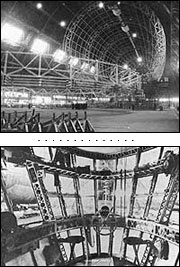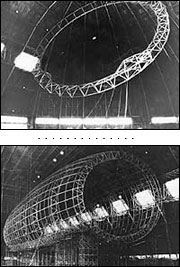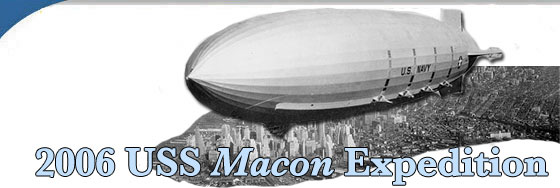The USS Macon: A Technical Perspective
 |
|
Top: USS Macon under construction. Bottom: View in the Macon's control car.
|
The USS Macon and her sister ship the USS Akron were designed and constructed by Goodyear-Zeppelin Corporation. Unlike today’s blimps, the dirigibles had sturdy frames and internal hulls. The USS Macon and USS Akron were called rigid airships because they were made of these rigid structures. These structures provided overall strength and tremendous access to interior portions of the dirigible. On the inside of the rigid airships, catwalks and girders allowed crewman to traverse the interior.
 |
|
Top: Erecting the Akron's first main frame ring. Bottom: USS Akron under construction.
|
In addition to catwalks and girders, the USS Macon and USS Akron also had internal hangars located about two-thirds of the way behind the nose of the airship. The airships could launch and retrieve five aircraft through a T-shaped opening in the floor of the hangar. Launching and retrieving the planes was a miraculous feat! A welded metal hook called a “sky hook” was attached to the top of each plane and was used to attach the plane to a trapeze. The trapeze and plane were lowered through the hangar floor. Pilots then had to rev up their engine RPMs, yank a release lever, and drop into the air mid-flight.
For the dirigible to retrieve the planes, pilots had to match their speed to the dirigible and gently guide the small hook back onto the trapeze. The plane was the lifted back into the dirigible. Sparrowhawk pilots were called the “men on the flying trapeze” due to their mid-air maneuvers.
The Sparrowhawk planes operated as eyes for the large airships. More maneuverable and capable of greater speed than the dirigible, the planes could scout large areas allowing the dirigible to remain far from enemy fighter planes.
USS Macon Facts
[modified, with permission, from the Moffett Field Historical Society]
- The Macon, unlike the blimps made today, had a structured duraluminum hull with three interior keels. The intent of the strong spine was to prevent a hull collapse. From the outside it looked and functioned much like a large blimp. On the inside, the ship was an open cavern of girders, cables and catwalks with few places where the crewmen could not go.
- The Macon was 785 feet long, just 97.5 feet shorter than the RMS Titanic and over four times the length of today’s Goodyear blimps. Link to Goodyear blimp site here.
- When carrying Sparrowhawks and personnel, the Macon weighed more than 400,000 pounds or the equivalent of two 100-ton blue whales.
- The Macon had accommodations for 100 officers and men, including sleeping berths, a large mess room, a galley, and observation platforms at the nose and tail.
- The Macon and her sister ship the Akron were kept aloft by non-flammable helium contained in twelve large cells inside the craft. The German airship Hindenburg was kept aloft by hydrogen, a more flammable gas than helium, and burst into flames on May 6, 1937.
- The Macon needed 6.5 million cubic feet of helium to become airborne. This is roughly equivalent to 216,666 bathtubs (measuring 5 feet by 3 feet by 2 feet) full of air.
- The Macon could fly at a top speed of eighty miles per hour. Flying at top speed it would take over 37 hours for the Macon to cross the United States.
- The Macon had eight large 560-horsepower gasoline powered German built Maybach reversible engines driving outside propellers. The Macon’s propellers could be rotated down or backwards to control the ship during take-off and landings.
- The Macon was housed at Moffett Field in Sunnyvale, California in 1934 and 1935. During her sixteen-month stay, the Macon became a familiar and popular sight.
- Moffett Field was named in honor of Navy Chief of Aeronautics Admiral, William A. Moffett who championed the lighter-than-air program and who was lost in USS Akron crashed.
- The Macon was the product of the Goodyear-Zeppelin Corporation, a business jointly owned by the Zeppelin Company of Germany and the Goodyear Tire and Rubber Company.
- The Macon was equipped with a scouting oddity known as the "spy" car. A cable would lower the amusing-looking compartment from the airship to a point below cloud cover up to 1,000 feet. A crewman inside the spy car would then telephone back to the main control room relaying navigational information. The car acted as a sort of reverse periscope.
|



